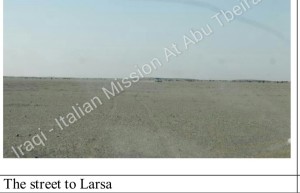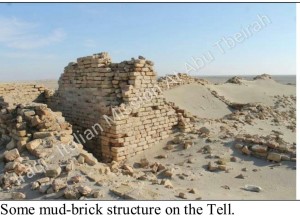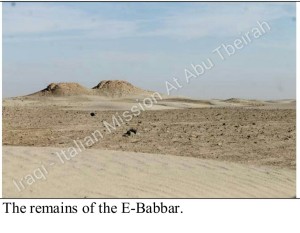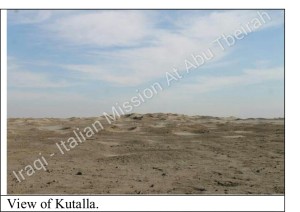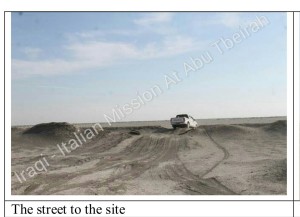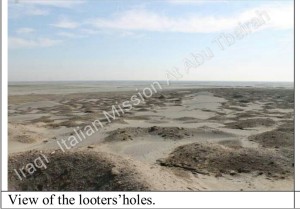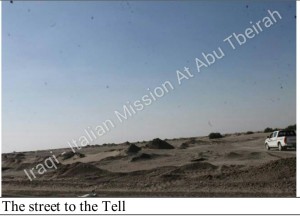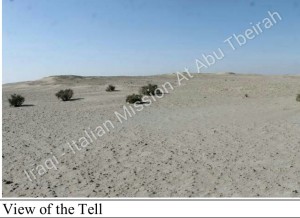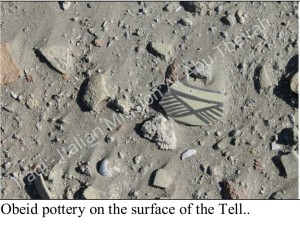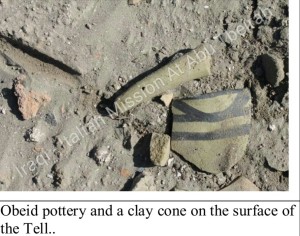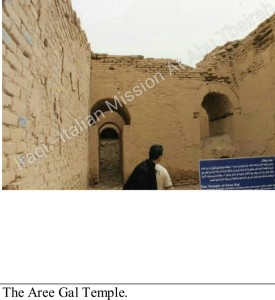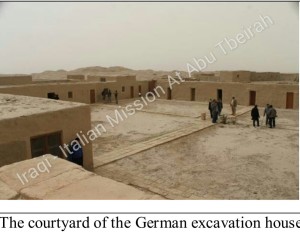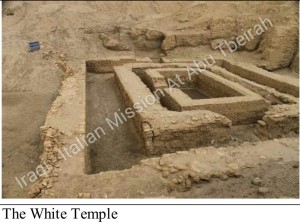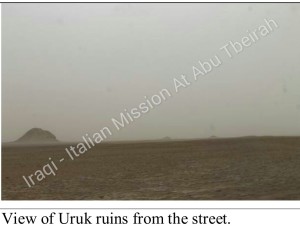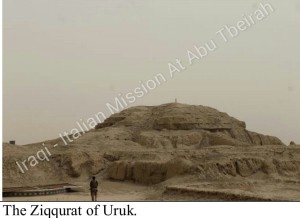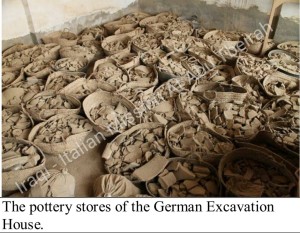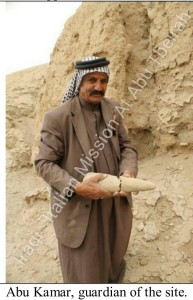1st Itinerary
Larsa (Tell Senkereh) – Kutalla (Tell Sifr) – Tell Awayli – Uruk (Warka, Muthanna)
Apart from Uruk (Warka), which is itself in the province of Muthanna – see below for more details –, the touristic characteristics and possibility of development of the sites in this itinerary is quite depressing. No indication whatsoever as for the place of the sites can be found on the highway (“As-shari’a”) and without the help of a local representative of the SBAH, who is almost inevitably the old guardian of the site or area, it would be impossible to get to the Tells. Notwithstanding this, it is to be noted that in respect to other more frequented sites of Dhi Qar , the sites of this area are more clean and give the impression of being more accurately kept. This is mainly due to their distance from inhabited places, and this also means that their accessibility is drastically reduced.
Larsa
The street to go to Larsa (Tell Senkereh) from Nasiriyah is adequate only up to 20 km from the provincial capital, then for the next 27 km it is absolutely necessary to have a 4-wheel drive car in order to reach the site. The way not only is not paved, but because of the wind and sand-storm of the area (especially in late spring and summer) there isn’t even a track for the car, so that many times it is necessary to find the way among bushes and sand dunes. The site itself, in the middle of an area which is mostly not inhabited, is quite impressive and has a peculiar and fascinating romantic appeal, but very few fragments of brick structures are visible (the temple Ebabbar, dedicated to the Sun-god, the base of the ziqqurat, some walls of a house dated to the Old Babylonian period, 1850 BC ca.). In any case, this is the most important Tell of the area. In the area where Larsa lies a lot of other minor Tells or archaeological places can be found, visible also from Tell Senkereh itself, and the entire zone is a sort of big “archaeological reservoir”.
Kutalla
The same difficulties described for reaching the site of Larsa can be equally repeated for the site ofTell Sifr – Kutalla. It is at a distance of few kilometres from Tell Senkereh so that it can be seen from Larsa, but the route is in the same way difficult and sometimes dangerous (while approaching the place, the car of the police which escorted us could not drive further, so that only our car couldgo until the vicinity of the site). While in Larsa only minor traces of looting can be detected, in Kutalla the area seems to have been looted more extensively, even if not at the degree of Jokha/Umma (see Itinerary 2 for details). Here, no visible structure can be seen on the surface and only the height of the site and the presence of pottery shards on the surface reveal the presence of an archaeological area.
Tell Awayli
This Tell, which lies in the same inhabited and impervious area, is at a distance of 15 km from Kutalla. It has been excavated by a French archaeological mission in the 80s, even if no structure whatsoever is to be seen on its surface. The site is dated to the late pre-historic period, so called Ubaid period (5500-4500 BC), and on its surface thousands of pottery shards belonging to that chronological span can be seen. Admittedly, the fascinating colours of the pottery of this period makes the visit to the Tell very interesting for a professional, but obviously not so for the novice.
Uruk
Notwithstanding it lies outside the border of the Dhi Qar Province, the city of Uruk is strictly tied to the cultural and archaeological framework of this region. It is one of the hugest and most well preserved archaeological site of Iraq, to be compared with Ur (and possibly also more attractive). Both structures from the oldest period (mid IVth millennium BC) up to the Babylonian time (VIth Century BC) are visible. Just like in Ur, a family of guards is in charge of the archaeological area and this has prevented any looting to the site (Abu Qamar, the present guardian, is very famous in Iraq and has been interviewed by many televisions in the last years). One very interesting aspect of the visit is the old house built by the first German archaeologists excavating the Tell at the beginning of the XXth Century AD, where many objects and memoirs can still be seen. The road, for the last 20 km, is in the middle of the desert and without a guide it is very easy to get lost. Notwithstanding this, the sight of the Tell, with its huge hill where the ziqqurat was placed, and other minor hills with palace and temple, is unique and really merits a visit.
Conclusions
The sites involved in this itinerary are surely interesting from the point of view of the location (landscape), but it is impossible today for tourists to make a “visit” on the tells, mainly because they are not excavated nor present any visible structure on their surface. Their historical importance is not visible in their present condition. New excavations, and a project of rehabilitation for touristicpurposes, is an absolute necessity. As said, the beauty of the places , will be in the future, once the sites will be prepared for tourists, a sure attractive for people visiting Dhi Qar.
Itinerario 1
Larsa (Tell Senkereh) – Kutalla (Tell Sifr) – Tell Awayli – Uruk (Warka, Muthanna)
Oltre a Uruk (Warka), che si trova nella provincia di Muthanna (vedi sotto per maggiori dettagli), le caratteristiche turistiche e la possibilità di sviluppo dei siti in questo itinerario è abbastanza deprimente. Nessuna indicazione per quanto riguarda il luogo dei siti può essere trovata in autostrada (“As-shari’a”) e senza l’aiuto di un rappresentante locale dello SBAH, che è quasi sempre il vecchio guardiano del sito o di zona, sarebbe impossibile arrivare ai Tells. Nonostante questo, è da notare che, rispetto ad altri siti più frequentati del Dhi Qar , i siti di questa zona sono più puliti e danno l’impressione di essere mantenuti con maggiore precisione. Ciò è dovuto principalmente alla loro distanza da luoghi abitati, e ciò significa anche che la loro accessibilità è drasticamente ridotta.
Larsa
La strada per andare a Larsa (Tell Senkereh ) da Nassiriya è adeguata solo fino a 20 km dal capoluogo di provincia , poi per i successivi 27 km è assolutamente necessario avere una macchina a 4 ruote motrici , al fine di raggiungere il sito . La strada non solo non è asfaltata, ma a causa del vento e delle tempeste di sabbia della zona (soprattutto durante la fine della primavera e in estate ) non c’è nemmeno un percorso per l’auto , cosicché molte volte è necessario trovare il modo tra cespugli e le dune di sabbia. Il sito stesso, è situato in una zona disabitata , è abbastanza impressionante e ha un fascino romantico e peculiare, ma pochissimi frammenti di strutture in mattoni sono visibili (il Tempio dell’ Ebabbar , dedicato al Sole-dio, la base della ziqqurat, alcune pareti di una casa datata al periodo antico babilonese, al 1850 aC ca.). In ogni caso, questo è il più importante Tell della zona. Nella zona in cui Larsa è situata si possono trovare numerosi Tells minori o siti archeologici, visibile anche lo stesso Tell Senkereh , infatti l’intera zona è una sorta di grande “serbatoio archeologico”.
Kutalla
Le stesse difficoltà descritte per raggiungere il sito di Larsa possono essere ugualmente ripetute per il sito di Tell Sifr – Kutalla. Esso è situato ad una distanza di pochi chilometri da Tell Senkereh, tanto che può essere visto da Larsa, ma il percorso è difficile allo stesso modo e talvolta pericoloso (avvicinandoci al luogo, la macchina della polizia che ci ha accompagnato non poteva guidare ulteriormente , solo la nostra macchina ha potuto raggiungere il sito). Mentre a Larsa possono essere rilevate solo tracce minori di saccheggi, la zona di Kutalla sembra essere stata saccheggiata più estesamente, anche se non al livello di Jokha / Umma (vedi itinerario 2 per i dettagli). Qui, nessuna struttura può essere vista sulla superficie e solo l’altezza del sito e la presenza di frammenti di ceramica rivela la presenza di una zona archeologica.
Tell Awayli
Questo Tell, che si trova nella stessa zona abitata e impervia delle precedenti, è ad una distanza di 15 km da Kutalla. E ‘stata scavata da una missione archeologica francese negli anni ’80, anche se nessuna struttura è stata portata in superficie. Il sito è datato al tardo periodo pre-storico , cosiddetto periodo Ubaid (5500-4500 aC), e sulla sua superficie si notato migliaia di cocci di ceramiche appartenenti a tale arco cronologico. Certo, i colori affascinanti della ceramica di questo periodo rende la visita del Tell molto interessante per un professionista, ma evidentemente non è così per un novizio.
Uruk
Nonostante si trova al di fuori del confine della Provincia del Dhi-Qar , la città di Uruk è strettamente legata al quadro culturale e archeologico di questa regione. Si tratta di uno dei siti archeologici più enormi e ben conservati dell’Iraq, da confrontare con Ur (e forse anche più attraente). Entrambe le strutture presenti sono visibili dal periodo più antico (metà IV millennio aC) fino al tempo babilonese (VI secolo aC). Proprio come ad Ur, una famiglia di guardiani è responsabile della zona archeologica e questo ha impedito qualsiasi saccheggio sul sito (Abu Qamar, l’attuale guardiano, è molto famoso in Iraq ed è stato intervistato da molte televisioni negli ultimi anni) . Un aspetto molto interessante della visita è la vecchia casa costruita dai primi archeologi tedeschi che hanno scavato il Tell all’inizio del XX secolo d.C., dove molti oggetti e memorie sono ancora visibili. La strada, per quanto riguarda gli ultimi 20 km, si trova nel mezzo del deserto e senza una guida è molto facile perdersi. Nonostante questo, la vista del Tell, con la sua enorme collina su cui è stata posta la ziqqurat, e le altre colline minori con palazzo e il tempio, è unica e davvero merita una visita.
Conclusioni
I siti coinvolti in questo itinerario sono sicuramente interessanti dal punto di vista della posizione (paesaggio), ma non è possibile oggi ai turisti di fare una “visita” sui Tell, soprattutto perché non sono stati scavati ne presentato alcuna struttura visibile sulla loro superficie. La loro importanza storica non è visibile nel loro stato attuale. Nuovi scavi, e un progetto di riabilitazione per scopi turistici, è necessaria. Come già detto, la bellezza dei luoghi , sarà in futuro, una volta che i siti saranno preparati per i turisti, una sicura attrazione per i turisti.
